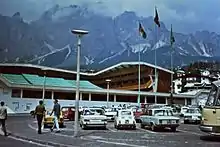Cristallo (mountain)
The Monte Cristallo (Italian pronunciation: [kriˈstallo]) is a mountain in the Italian Dolomites, northeast of Cortina d'Ampezzo, in the province of Belluno, Veneto, northern Italy. It is a long, indented ridge with four summits higher than 3,000 metres. The mountain range is part of the "Natural Park of the Ampezzo Dolomites".[2]
| Cristallo | |
|---|---|
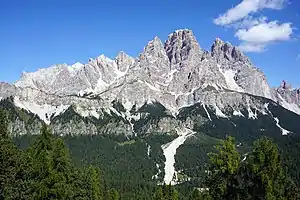 Cristallo, south side | |
| Highest point | |
| Elevation | 3,221 m (10,568 ft) |
| Prominence | 1,416 m (4,646 ft) [1] |
| Listing | Alpine mountains above 3000 m |
| Coordinates | 46°35′00″N 12°11′00″E |
| Geography | |
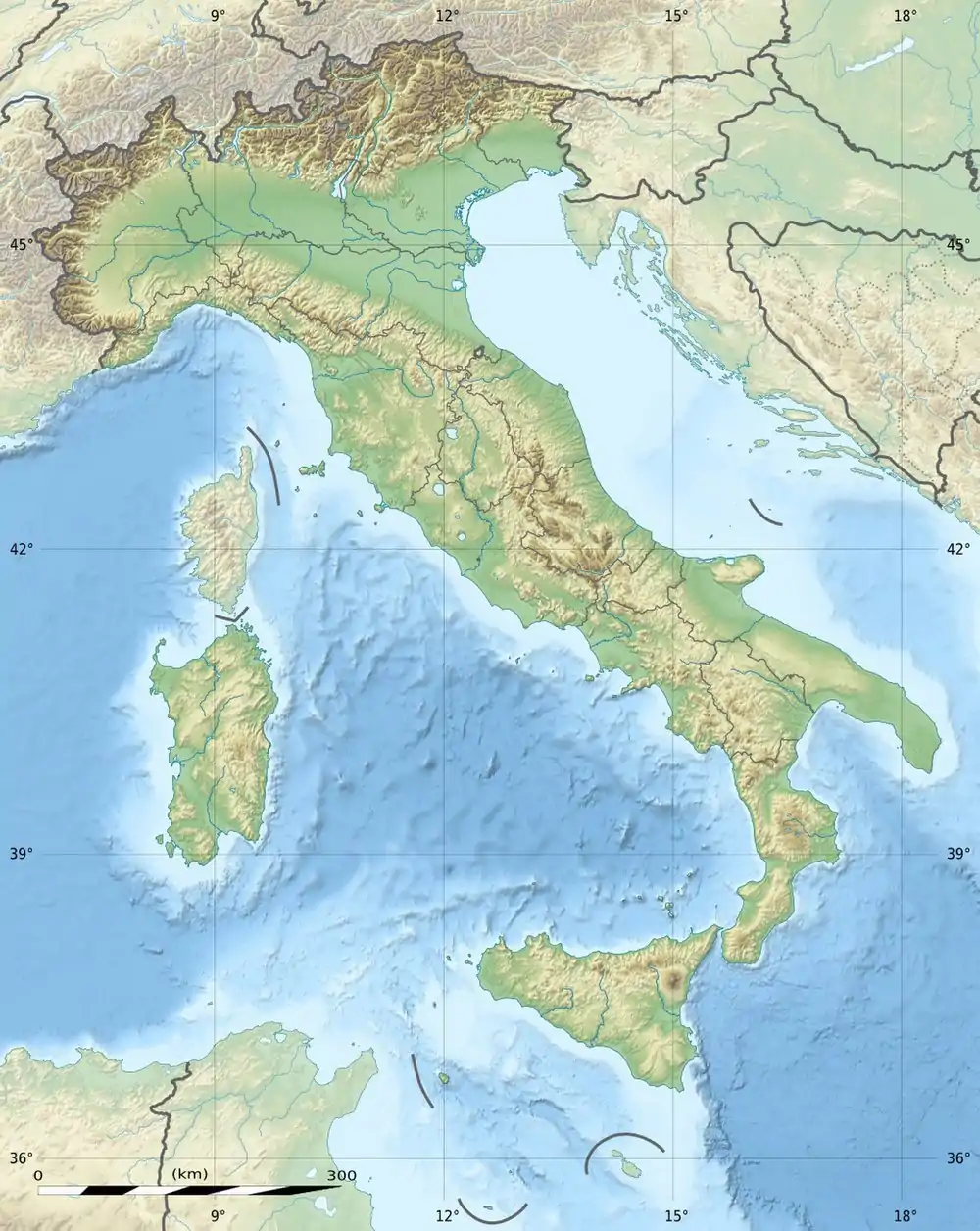 Cristallo Italy | |
| Location | Belluno, Italy |
| Parent range | Dolomites |
| Climbing | |
| First ascent | 1865 (Paul Grohmann, Angelo Dimai, Santo Siorpaes) |
In the north of the Cristallo group is the 1,530 m high mountain pass "Cimabanche" (in German: "Im Gemärk" also "Gemärk Pass", in Ladin: "Sorabances"), in the south the mountain pass Tre Croci (1,809 m - in Ladin: "Son Zuógo").
Peaks
The highest peaks of the Cristallo massif are Monte Cristallo (3,221 m), Cima di Mezzo (3,154 m), Piz Popena (3,152 m) and Cristallino d'Ampezzo (3,008 m). Cima di Mezzo and Cristallino d'Ampezzo can be reached by via ferratas, while Monte Cristallo and Piz Popena both require climbing skills.
First climbs
- Monte Cristallo (3,221 m): 1865 (Paul Grohmann, Angelo Dimai, Santo Siorpaes),[3][4][5] 1874 (first woman: Anna Ploner)[6]
- Cima di Mezzo (3,154 m): 1881 (John Stafford Anderson, Santo Siorpaes, Giuseppe Ghedina)[3]
- Piz Popena (3,152 m): 1870 (Eduard R. Whitwell, Santo Siorpaes, Christian Lauener)[3][7]
- Cristallino d'Ampezzo (3,008 m): 1886 (Michael Innerkofler, A. Angerer)[3]
- Campanile Dibona, Monte Cristallo - west peak, 2,550 m (8,370 ft), 1908 - solo Angelo Dibona[8]
Geology
Cristallo is largely formed from the Upper Triassic dolomitic rock Dolomia principale. The mountain was formed during Cretaceous, as well as the rest of the Dolomites, due to the collision between the African and European continents.
Access
A cable lift system starts from Rio Gere in Val Begontina, first a lift to Rifugio Son Forca at the upper end of Val Padeon. The gondola lift up to Forcella Staunies (2,919 m), close to Rifugio G. Lorenzi (2,932 m), was built for the Winter Olympics in Cortina in 1956. Both the lift and the refuge closed in summer 2016 due to "technical and administrative problems".[9]
The Dolomite Highway number 3 goes through the eastern part of the massif.
Via ferratas
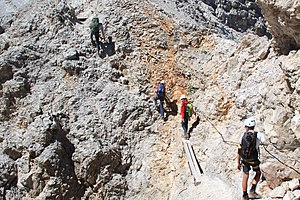
The two via ferratas VF Ivano Dibona and VF Marino Bianchi both start from the top of the cable car at Forcella Staunies. VF Marino Bianchi can be followed to the peak Cima di Mezzo.[10]
VF Ivano Dibona follows the Zurlon-ridge. It is a historical route used in World War I, and later restored and made safe for tourists.[11][12] At the beginning is the longest via ferrata suspension bridge in the Dolomites, the 27-metre-long Ponte Cristallo.[10][12]
The via ferrata VF Renato de Pol can be used for access from the western side of the Cristallo massif.[10]
Winter sports
Cristallo is one of the major skiing areas in the surroundings of Cortina. To the east of Monte Cristallo there is a small ski area at Lake Misurina.
Cabins (rifugi) and restaurants
Some of the cabins and restaurants available are the Rifugio Son Forca at 2,235 m; Capanna Guido Lorenzi at 3,003 m (Auronzo di Cadore); Ristorante Rio Gere at 1,680 m; Ristorante Lago Scin at 1,336 m; Ristorante Staulin at 1,370 m; Ristorante Son Zuogo at 1,800 m.
History
During the World War I there was considerable military activity in the mountain. The front lines between Italian and Austro-Hungarian troops went through the mountains. Remains of ladders and barracks are still found today, and transport lines (ferratas) have been restored. At the passes Cimabanche and Tre Croci there are Italian bunkers from the time of World War II.
Popular culture
In 1993 the film Cliffhanger was shot on and around the bridge on the Zurlon-ridge, as well as some of the other peaks in the area. The mountain film The Blue Light from 1932 revolves around Monte Cristallo.
A legend narrates that on Monte Cristallo lived a beautiful princess who had many suitors, whom she always turned down.[13]
See also
Gallery
 Monte Cristallo from the north with the Dürrensee in the foreground
Monte Cristallo from the north with the Dürrensee in the foreground Monte Cristallo from the north with the Dürrensee in the foreground
Monte Cristallo from the north with the Dürrensee in the foreground Forcella Staunies and Rifugio Lorenzi seen from Cristallino d'Ampezzo, in the background the Piz Popena
Forcella Staunies and Rifugio Lorenzi seen from Cristallino d'Ampezzo, in the background the Piz Popena Monte Cristallo from the south
Monte Cristallo from the south.jpg.webp) Monte Cristallo from the south, left the Forcella Staunies
Monte Cristallo from the south, left the Forcella Staunies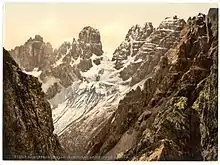 The glacier of the Monte Cristallo and Piz Popena group (before 1900)
The glacier of the Monte Cristallo and Piz Popena group (before 1900)
References
- Cortina d'Ampezzo e Dolomiti Ampezzane. 1:25,000, Carta Topografica. Casa Editrice Tobacco.
- Karl Felix Wolff (2013) The Dolomites And Their Legends (Bolzano, Edition Raetia), ISBN 978-88-7283-436-7[14]
Notes
- "Monte Cristallo". peakbagger.com. Retrieved 9 January 2016.
- Natural Park of the Ampezzo Dolomites
- Goedeke, Richard; Kammerer, Hans (1993). 3000er der Dolomiten (in German). Tappeiner Verlag. p. 240. ISBN 88-7076-155-3.
- La Conquista delle vette dolomitiche – abcdolimiti.com (Retrieved on 21 September 2008) (in Italian)
- Allgemeine Informationen über die Geschichte der örtlichen Alpinistik mit besonderem Bezug auf die historischen Aufstiege und auf die "ersten Wege" Archived 14 May 2006 at the Wayback Machine – dolomito.altevio.it (Retrieved on 21 September 2008) (in German)
- W. Eckerth: Die Gebirgsgruppe des Monte Cristallo. Ein Beitrag zur Kenntnis der südtirolischen Dolomit-Alpen. Second, expanded and revised edition. Prague 1891, p 24.
- W. Eckerth: Die Gebirgsgruppe des Monte Cristallo. Ein Beitrag zur Kenntnis der südtirolischen Dolomit-Alpen. Second, expanded and revised edition. Prague 1891, pp 90.
- Klier, Walter (2006). Stubaier Alpen alpin: Alpenvereinsführer für Hochalpenwanderer und Bergsteiger. Bergverlag Rother. p. 373. ISBN 978-3-7633-1271-9.
- http://www.planetmountain.com/en/news/trekking/staunies-historic-cable-car-closes-above-cortina.html
- Smith, John; Graham Fletcher (2002). Via ferratas of the Italian Dolomites: Volume 1 [North, central and east]. UK: Cicerone. pp. 310pp. ISBN 1-85284-362-4.
- Sentiero Ivano Dibona (Retrieved on 21 September 2008)
- Sentiero ferrato Ivano Dibona – (Retrieved on 21 September 2008)
- Morena Arnoldo "Bondi Cortina. Discover the Ampezzo Valley with this guide." (2000) p 30.
- "Archived copy". Archived from the original on 13 August 2013. Retrieved 11 September 2013.CS1 maint: archived copy as title (link)
